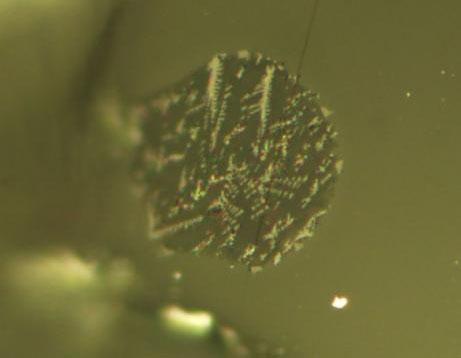Lunar melt inclusions are tiny globules of molten rock trapped within crystals that are found in volcanic glass deposits formed during explosive eruptions. The new findings show lunar magma water contents are 100 times higher than previous studies have suggested.
The study is the culmination of years of investigation by the team searching for water and other volatiles in volcanic glasses returned by NASA Apollo missions in the late 1960s and early 1970s. In 2008, a same team led by Alberto Saal, associate professor of geological sciences at Brown, reported the first evidence for the presence of water and used models to estimate how much water was originally in the magmas before eruption.
They found the melt inclusions that allowed the team to measure the pre-eruption concentration of water in the magma and to estimate the amount of water in the Moon’s interior, in a classic needle-in-the-haystack effort. Brown undergraduate student Thomas Weinreich searched through thousands of grains from the famous high-titanium "orange soil" discovered by astronaut Harrison Schmitt during the Apollo 17 mission before finding ten that included melt inclusions.

Tiny melt inclusions in lunar soil samples that opened the door for measurements that revealed the magnitude of water inside the moon. Credit: Saal lab/Brown University
Compared with meteorites, Earth and the other inner planets contain relatively low amounts of water and volatile elements, which were not abundant in the inner solar system during planet formation. The even lower quantities of these volatile elements found on the Moon has long been claimed as evidence that it must have formed following a high-temperature, catastrophic giant impact. But this new research shows that aspects of this theory must be reevaluated.
“Water plays a critical role in determining the tectonic behavior of planetary surfaces, the melting point of planetary interiors and the location and eruptive style of planetary volcanoes,” said Erik Hauri, a geochemist with the Carnegie Institution of Washington and lead author of the study. “We can conceive of no sample type that would be more important to return to Earth than these volcanic glass samples ejected by explosive volcanism, which have been mapped not only on the moon but throughout the inner solar system.”
The research team measured the water content in the inclusions using a state-of-the-art NanoSIMS 50L ion microprobe.
“In contrast to most volcanic deposits, the melt inclusions are encased in crystals that prevent the escape of water and other volatiles during eruption. These samples provide the best window we have on the amount of water in the interior of the Moon,” said James Van Orman of Case Western Reserve University, a member of the science team.
The study also puts a new twist on the origin of water ice detected in craters at the lunar poles by several recent NASA missions. The ice has been attributed to comet and meteor impacts, but it is possible some of this ice could have come from the water released by eruption of lunar magmas.





Comments